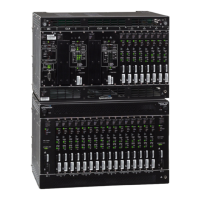1
097-55501-01 Issue 6 – June 2003 25
2
5
3
Description
will be selected as the active timing reference. The quality level
associated with each input can be read using the CURRSSM
keyword. There is no preference given to an input that is actually
extracting SSM values (requires enabling SSMENB) compared with
one that is using an assumed SSM quality level (SSMENB
disabled).
• If more than one qualified input has the same SSM quality level,
the SSMPRI (SSM Priority) setting completes the selection. In such
a case, the qualified input with the numerically lowest SSMPRI
setting will be selected as the active reference.
• If the CURRSSM quality value for an otherwise qualified input is
numerically higher than the quality level of the internal reference
oscillator in the clock card, that input will be disqualified and
hence cannot be selected as the active timing reference. The
rationale for this is that the internal reference oscillator will
provide a better timing reference than any input with a lower
quality level. The quality levels for TimeHub 5500 internal
oscillators are 3 for any rubidium type clock (090-55513-01 and
090-55514-02) (Stratum 2 traceable) and 5 for any quartz type
clock (090-55511-01 and 090-55512-02) (Stratum 3E traceable).
The QCUTOFF keyword can be used to set an additional quality
value that will disqualify any input whose CURRSSM value is
larger than the selected QCUTOFF value.
1.3.4.3 Output SSM
SSM encoding will occur for any DS1 output that has been selected to have
ESF framing. Normal operation will automatically provide an appropriate
SSM quality level on such outputs, but there is also provision to override the
automatic setting and manually set the quality level to be encoded on DS1
ESF outputs. Here are some details regarding how the SSM quality level is
set for ESF outputs:
• During normal operation, where a qualified input is being used as
the active timing reference, the SSM quality level of that input will
be copied to all DS1 ESF outputs. This quality level can be read by
retrieving the CURRSSM value, selecting the currently active
timing reference. If the active reference changes to a different
input, the SSM output will become that of the newly selected input.
Note that the SSM value is output on DS1 ESF outputs regardless
of the selected synchronization mode (see SYNCMDE discussion
above). It isn't necessary for SYNCMDE to be set to "SSM" for
outputs to encode SSM information.
• When the TimeHub 5500 is using an internal oscillator as the
timing reference source, the output SSM quality level will be the
quality level appropriate to the performance level of that internal

